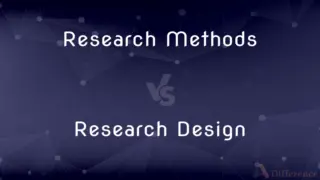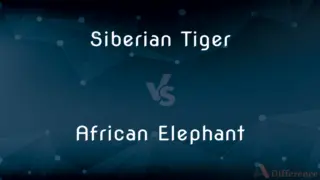Absolute Dating vs. Relative Dating — What's the Difference?
Edited by Tayyaba Rehman — By Fiza Rafique — Published on December 8, 2023
Absolute Dating determines exact age; Relative Dating determines age compared to other items.

Difference Between Absolute Dating and Relative Dating
Table of Contents
ADVERTISEMENT
Key Differences
Absolute Dating is a method used by scientists to determine the actual age of a specimen. It uses quantitative measurements and formulas to pinpoint an exact time frame, such as years before the present. On the other hand, Relative Dating is a technique employed to determine the age of a specimen relative to other items or layers. It doesn't give an exact age but instead indicates if something is older or younger than another item.
In the realm of archaeology and geology, Absolute Dating can use techniques such as radiometric dating where isotopes decay at known rates. This gives scientists an accurate window of time in which a fossil or artifact existed. In contrast, Relative Dating might involve studying layering in rock or sediment, with the understanding that deeper layers are older than those above them.
Absolute Dating requires specialized tools and equipment. Techniques like carbon-14 dating or dendrochronology (tree-ring dating) are rooted in exact science and demand precise measurements. Relative Dating, conversely, often leans on more visual or location-based cues. For instance, if an artifact is found in the same layer as another item of known age, it's inferred they're from the same time period.
When employing Absolute Dating, the result is often expressed in a specific number of years or a range of years. This can provide invaluable information for researchers trying to construct a detailed timeline. In the case of Relative Dating, the outcomes are more comparative, often using terms like "older," "younger," or "contemporary" to describe relationships between specimens.
Comparison Chart
Determination of Age
Gives exact age.
Compares age to other items.
ADVERTISEMENT
Techniques Used
Radiometric dating, etc.
Layering, stratigraphy, etc.
Tools Required
Specialized tools & equipment
Visual or location-based cues
Expressed Outcome
Specific number of years.
Terms like "older" or "younger"
Main Use
Archaeology, geology.
Archaeology, geology.
Compare with Definitions
Absolute Dating
Absolute Dating determines an item's precise age.
Using radiometric techniques, the archaeologist used Absolute Dating to determine the fossil's age.
Relative Dating
Relative Dating often uses stratigraphic principles.
Using principles of stratigraphy, the geologist applied Relative Dating techniques.
Absolute Dating
Absolute Dating uses quantitative measurements.
Carbon-14 is a popular method for Absolute Dating in archaeology.
Relative Dating
Relative Dating helps in constructing chronological sequences.
Using Relative Dating, the archaeologist established a timeline for the site's occupation.
Absolute Dating
Absolute Dating techniques are rooted in specific sciences.
Dendrochronology, an Absolute Dating method, is based on tree-ring patterns.
Relative Dating
Relative Dating doesn't give an exact age.
Through Relative Dating, we deduced the artifact is older than the surrounding items.
Absolute Dating
Absolute Dating often requires specialized equipment.
With the mass spectrometer, they carried out Absolute Dating on the artifact.
Relative Dating
Relative Dating determines age by comparison.
The fossil was found below another layer, so using Relative Dating, it's deemed older.
Absolute Dating
Absolute Dating provides a direct age estimate.
Through Absolute Dating, the tree's age was pegged at 1500 years.
Relative Dating
Relative Dating is based on position or correlation.
Due to its position in the rock layer, Relative Dating suggests this specimen is ancient.
Common Curiosities
What tools are often used in Absolute Dating?
Tools like mass spectrometers and radiometric equipment are used in Absolute Dating.
How does Relative Dating indicate age?
Relative Dating shows the age of a specimen compared to others.
What does Absolute Dating determine?
Absolute Dating determines the exact age of a specimen.
Can Relative Dating give a specimen's exact age?
No, Relative Dating only provides age in relation to other specimens.
Why might archaeologists use Relative Dating?
Relative Dating helps archaeologists understand a specimen's age in relation to its surroundings.
Is tree-ring dating a form of Absolute or Relative Dating?
Tree-ring dating, or dendrochronology, is a form of Absolute Dating.
How does carbon-14 dating fit into these categories?
Carbon-14 dating is a method of Absolute Dating.
Which dating method requires more specialized equipment?
Absolute Dating generally requires more specialized tools.
Can both dating methods be used on the same specimen?
Yes, both Absolute and Relative Dating can be applied to provide a comprehensive age profile.
Why is stratigraphy important in Relative Dating?
Stratigraphy, the study of rock layers, is foundational in determining age relationships using Relative Dating.
Can Relative Dating be used for items in the same layer?
Yes, items in the same layer are often deemed to be of similar age using Relative Dating.
Is sediment layering related to Absolute or Relative Dating?
Sediment layering is primarily used in Relative Dating.
Are there any limits to Absolute Dating?
Yes, certain methods like carbon-14 dating have limits based on the half-life of the isotope.
How do geologists use Relative Dating?
Geologists use Relative Dating to understand the sequence of events in Earth's history.
Which method gives a more definitive age?
Absolute Dating gives a more definitive age compared to Relative Dating.
Share Your Discovery

Previous Comparison
Research Methods vs. Research Design
Next Comparison
Siberian Tiger vs. African ElephantAuthor Spotlight
Written by
Fiza RafiqueFiza Rafique is a skilled content writer at AskDifference.com, where she meticulously refines and enhances written pieces. Drawing from her vast editorial expertise, Fiza ensures clarity, accuracy, and precision in every article. Passionate about language, she continually seeks to elevate the quality of content for readers worldwide.
Edited by
Tayyaba RehmanTayyaba Rehman is a distinguished writer, currently serving as a primary contributor to askdifference.com. As a researcher in semantics and etymology, Tayyaba's passion for the complexity of languages and their distinctions has found a perfect home on the platform. Tayyaba delves into the intricacies of language, distinguishing between commonly confused words and phrases, thereby providing clarity for readers worldwide.














































